Ivory History

Wooly Mammoth, 20,000 years old, discovered in August 2008; Vogelherd Cave, Lonetal; Swabia, Germany.
Nearly every culture has produced objects from ivory. We have ivory from ancient China, Egypt, Greece, and Rome, as well as ancient Japan, Iran, Afghanistan, and India. Ivory has been valued as a luxury item since the beginning of recorded antiquity.

Ivory statue of pregnant woman, excavated at Laussel, Dordogne, France.
Prehistory
Ivory, horn, and bone carvings have been found from Stone Age settlements, particularly in the Dordogne region of France. The first ones are crude statues of women. The ivory figure below is remarkable for being intact, though it was found in Germany.
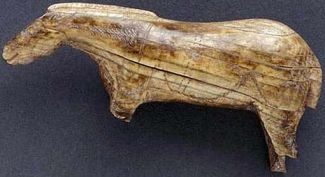
Ivory horse, excavated at the Grotte des Espelugues, Lourdes, Hautes Pyrenees. Length 7.5 cm. Musee de Saint-Germain-en-Laye, France.
The carvings of animals in ivory during Magdalenian times (16,000 - 11,000 B.C.) are more detailed and sophisticated than those of the Upper Paleothic period. Magdelania was a period of intricate skill in carving. Animals in particular were rendered with great precision allowing modern scholars to determine which now-extinct animals once lived in Europe.
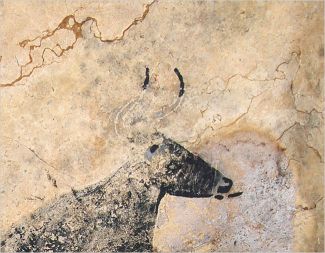
Cow's head, cave wall, Lascaux, France
During the Magdalenian era, which began about 17,000 years ago, the caves in Lascaux, Chauvet, Cougnac, and Cosquer in France as well as Altimira, Spain and various sites in the Pyrenees, were elaborately painted. There are about 125 such sites in Southern France and Northern France. Their great antiquity was not understood until the 1879 publication of a study by a French school teacher Leopold Chiron.
Horses and bison appear together frequently in the cave paintings of this period. Scholars are not certain of the significance of this coupling. The ivory carvings of horses we have from this prehistoric period bear remnants of pigment. In remote antiquity, white horses were sometimes sacrificed to the gods of the sun and earth, while black horses were sacrificed to the gods of the underworld.
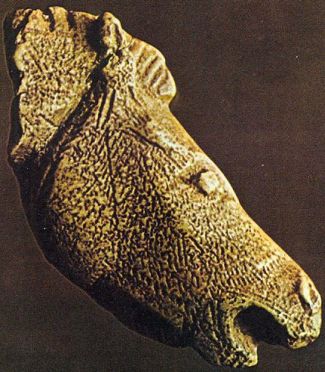
Bone horse head; ca. 12000 BC. The structure of the bone did not allow for carving in the round, and the reverse side is flat. Abri du Roc-aux-Sorciers, cave Taillebourg, Angles-sur-L'Anglin (Vienne, France).
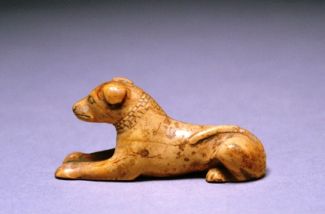
Dog gaming piece, Egyptian, Hippopotamus ivory; ca. 3000-2900 BC; 1 3/16 x 2 9/16 x 13/16 in.; The Walters Museum of Art, Baltimore, MD.
In Egypt and the Ancient Near East, ivory was highly valued and intensely traded.
There is scant information about games in early Egyptian antiquity, but scholars believe the object below is a gaming piece. The games of antiquity are thought to have their origin in religious rituals. Many games were placed in Egyptian tombs to entertain the deceased during the afterlife. The dog game piece may have been part of such a post-mortem game.
In hieroglyphics, the word for dog is Iw-iw. For the ancient Egyptians, there was little distinction between jackals and dogs. Specific breeds from ancient Egypt have not been distinguished. Dogs in ancient Egypt were used for hunting or less often as pets. They were sometimes buried in the same coffin as their masters or in a separate coffin in their masters’s tomb. This dog clearly belonged to someone—it has a collar. Given its rare material and its exquisite carving, it was probably made for a nobleman.
There is documentary evidence of the import of ivory from India to Mesopotamia. So even if elephants existed in the ancient Near East, collectors and craftsmen preferred Indian ivory. According to archaeologists, the Near Eastern elephant was hunted to extinction in about 1500 B.C.
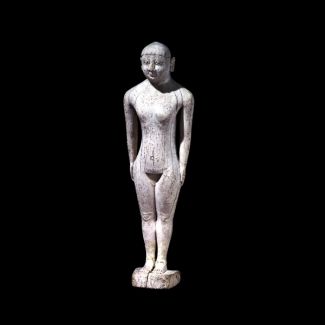
Statue of a woman, Hittite Anatolia, ca. 1650 B.C.; 4.43 inches; British Museum, London, U.K.
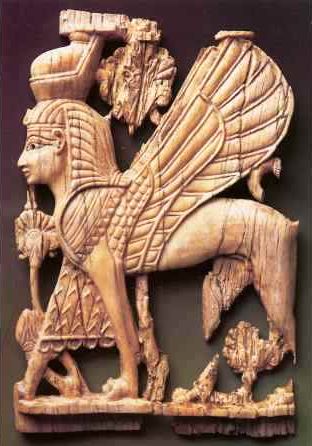
Syrian ivory Sphinx/Cherub; Eighth century B.C.; Jerusalem Museum, Israel.
Much of the ivory found in ancient Mesopotamia was probably made in Phoenicia or Syria. There is more evidence of organized, sophisticated ivory-carving there than in Mesopotamia. Ivory pieces were likely acquired by the Mesopotamians as booty, tribute, or in some cases, outright trade.
Ancient Near Eastern and Egyptian craftsmen used ivory for furniture decorations, to ornament horse’s bridles, to create cosmetic’s containers, as holders for mirrors or fly swatters. On furniture, ivory was cut into relief and sometimes painted.
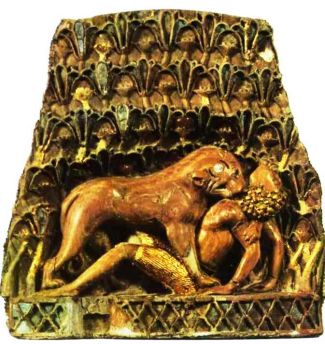
Ivory with inlaid gold, lapus lazuli, carnelian; Lion mauling a Nubian in papyrus field; ca. 721 B.C.; 4 ½ x 4 ½ inches; British Museum; London, U.K.
A large collection of ivory was excavated by Sir Max Mallowan at Nimrud (known in antiquity as Kalhu) just after World War II. Nimrud was the capital of King Ashurnasirpal II (883-859 B.C.), whose palace took fifteen years to construct and set new standards for conspicuous consumption.
The importance of ivory for the ancient near east is shown in the Bible. King Solomon’s immense wealth was demonstrated by his possession of ivory.
“Moreover, the king made a great throne of ivory and overlaid it with refined gold. There were six steps to the throne and a round top to the throne at its rear, and arms on each side of the seat, and two lions standing beside the arms. Twelve lions were standing there on the six steps on the one side and on the other; nothing like it was made for any other kingdom.”
[from 1 Kings 10 New English Bible translation]
